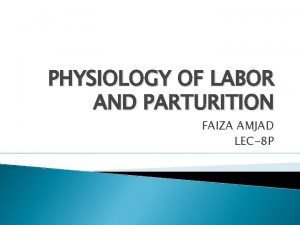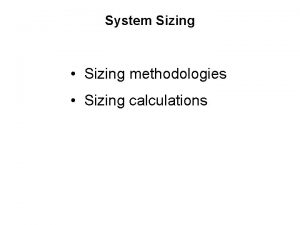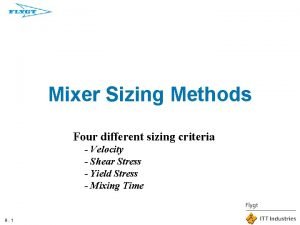Desizing Faiza Anwar Sizing and Sizing Agents Sizing
















- Slides: 16

Desizing Faiza Anwar

Sizing and Sizing Agents � Sizing is the process of application of a composition of matter applied to warp yarns, before weaving, for the sake of their protection against abrasive stresses during weaving � Classification ◦ Natural ◦ Synthetic � Commercial of Sizes sizing chemistries ◦ For Cotton: Starch, Carboxymethyl cellulose (CMC), Natural gums ◦ For Regenerated Cellulosics: Protein based glue, gelatin ◦ For Synthetics: Polyvinyl alcohol (PVA), Polyacrylic acid, CMC, plasticised acidic vinyl acetate and acidic methyl acrylate polymers, and polyester based materials.

Desizing and Its Types � The object is to remove from the grey fabric the size that has been applied during weaving and thus to make the fabric ready for further processes. � Desizing is the process in which the size applied to the warp yarn before weaving is removed to facilitate the penetration of dyes and chemicals in the subsequent wet processing operations � Starch is converted into water soluble form � Synthetic sizes are removed during scouring solubization, saponification and emulsification

Types of Desizing

Enzymatic Desizing � “Enzyme” is a Greek word. Means yeast � The are organic biocatalysts and are classified as proteins with high molecular weights � Can be taken from ◦ Animal sources (Clotted blood, liver, pancrease) ◦ Plant sources (Malt extract, Bacterial) � Are very specific wrt reaction catalysis and substrate

Enzymatic Desizing � Enzymes for starch are called Amylase (mixture of α and β) named after amylose in starch � They hydrolyze the starch molecule into smaller water soluble molecules � For other sizing materials such as glue and gelatin enzymes used are different such as Gelatase � For starch/ lubricant (form complex) mixture Lipase is used along with amylase

Enzymatic Desizing � The Process ◦ Batch wise ◦ Continuous �Application of Enzyme �Digestion of Starch �J box (75 C for 30 min) �Steamer (30 -60 sec) �Batching (8 -16 hrs) �Removal of digested products from fabric (with a hot wash) � Recipe ◦ ◦ ◦ Amylase enzyme p. H stabilizer (at 6. 5 -7) Chelating agent (not for malt enzyme) Salt Surfactant Temperature is maintained 60 -70 C

Enzymatic Desizing � Activity of Enzyme depends on ◦ Time, Temperature, p. H and concentration � The enzymes are only active within a specific range of p. H and temperature. � Time of digestion depends on Concentration � Effect of temperature ◦ Stability of enzyme decreases with increase in temperature and it usually becomes inactive above 75 C (salts may be used to increase the stability to temperature) ◦ However activity of enzyme is doubles with every 10 C rise in temperature

Effect of p. H on Enzyme Activity Effect of Temperature on Enzyme Activity Effect of Time on Enzyme Activity

Enzymatic Desizing � Optimum Concentration, Temperature and p. H for different enzymes

Acid Desizing � Fabric is treated with dilute sulphuric or hydrochloric acid ◦ Concentration required; 5 -10 g/L ◦ Temperature; about 40 C ◦ Time; 3 -4 h � Acid attacks the polymer chain of starch and due to chain cleavage (by hydrolysis) of starch molecule short water soluble � Concentration and temperature should be controlled strictly ◦ Not safe above 10 g/L and 50 C

Acid Desizing � Effect of rise in temperature has dual ◦ rate of reaction doubles for each 10 C rise in temperature � Fabric shouldn’t be dried otherwise hydrocellulose will form � Suitable for cotton varieties containing large metal contents (converted to water soluble sulphates)

Acid Desizing � Disadvantage ◦ There’s always a chance of tendering due to hydrolysis of cellulose into hydrocellulose

Oxidative Desizing � Here the starch molecules are broken down to water soluble form by oxidation � Though the use of oxidants, desizing of cotton fabric is widely accepted but their large scale industrial application is yet to be exploited. � The most important aspects of oxidizing agents are that they can be applicable to wide range of fabrics, the size content of which is often not known. � Sodium hypochlorite, sodium hypobromite and sodium or potassium persulfate

Oxidative Desizing � This method is not used much either because it too degrades cellulose fibers

Evaluation of Desizing �A drop of iodine solution placed on a test specimen resulting in a characteristic blue color is the universal test for identifying starch. � It can be used as a qualitatively test to show whether all the starch was removed. � Absence of the blue color signifies that all the starch has been removed. The intensity of the color is some what related to how much is left.
 Types of desizing methods
Types of desizing methods Lahalibo 1949
Lahalibo 1949 Faiza rafique
Faiza rafique Faiza asghar
Faiza asghar Dr faiza asghar death
Dr faiza asghar death Stages of labor
Stages of labor Victorian era literature characteristics
Victorian era literature characteristics Faiza bhatti
Faiza bhatti Carotenmia
Carotenmia Rudy hartono endang suryaningsih
Rudy hartono endang suryaningsih Puisi kepemimpinan chairil anwar
Puisi kepemimpinan chairil anwar Sahar anwar
Sahar anwar Makna dari puisi aku karya chairil anwar
Makna dari puisi aku karya chairil anwar Amanah lestari alam
Amanah lestari alam Development and maturation
Development and maturation Anwar tjen
Anwar tjen What is anwar
What is anwar






























